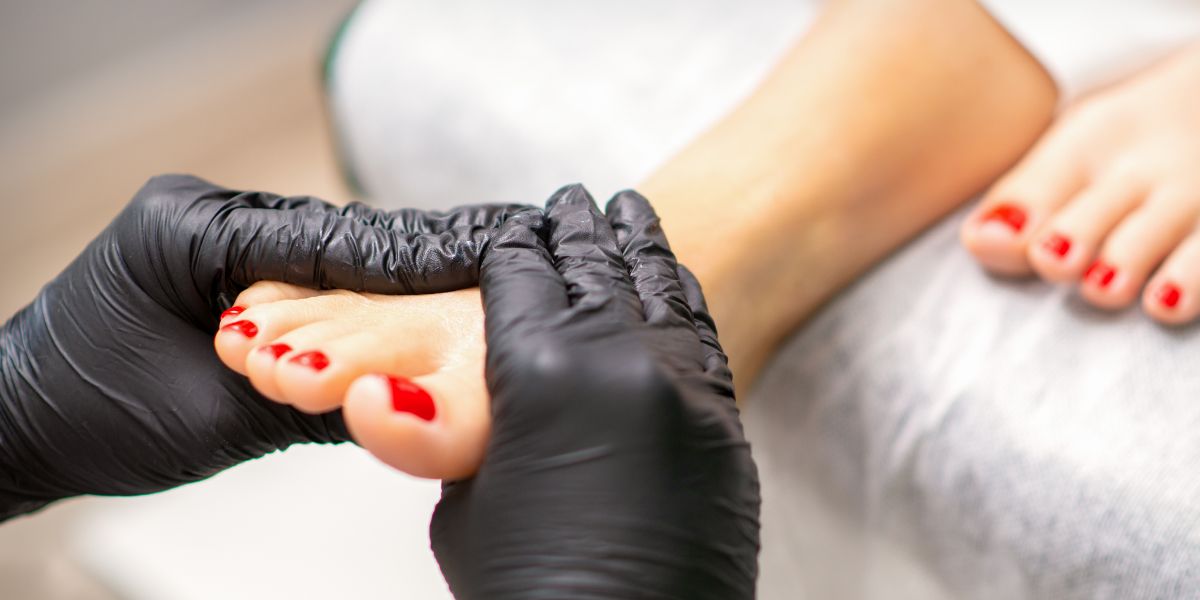Diabetes often means that there is a greater risk of a foot condition becoming serious so it’s important to let your doctor know if you have symptoms of any of the foot conditions in this guide.
It’s important not to dismiss a foot problem as mild as each of the problems listed has the potential to be serious when diabetes is present.
When contacting your doctor about any of these conditions, ensure the health team, including receptionist know that you have diabetes.
Causes of diabetic foot problems
There are a range of different foot complications which may each have different causes but there are some causes that are common to a number of foot problems.
Poorly fitting shoes can lead to rubbing of skin causing blisters and corns and shoes that don’t leave enough room for all the toes may increase the chance of bunions or hammer toes occurring.
Walking barefoot raises the risk of suffering a foot wound or, particularly in hot weather, burns.
Having neuropathy can significantly increase the risk of a foot condition occurring as you may not sense when your feet are becoming aggravated or damaged.
Having poor blood circulation can also lead to a number of foot problems.
Preventing foot problems
There are a number of ways you can reduce the chances of developing a foot problem, which include:
- Wearing shoes that fit well
- Avoiding walking bare foot
- Keeping feet clean
- Keeping feet moisturised
- Importantly – checking your feet for signs of damage on a daily basis
Athlete’s foot (tinea pedis)
A fungal infection of the foot characterised by a rash between the toes which may be itchy and cause dry, flaky skin
Athlete’s foot can lead to fungal infection of the toenails and may cause skin on your feet to crack which can lead to infection and therefore can be a serious problem for those of us with diabetes.
Blisters
Often caused by rubbing of skin against shoes, blisters are when fluid builds up under the top layers of skin. Burst blisters carry a risk of infection so do not attempt to burst a blister.
Bunions (hallux valgus)
A bunion is said to occur if your big toe points towards the neighbouring toes of that foot. This can cause the big toe to rest on one or more of the other toes and push the bone leading to the big toe (this bone is called the first metatarsal) to stick out.
The cause of bunions is not so well understood but family history is believed to be a strong factor and badly fitting shoes may worsen the problem. Treatments include measures to relieve problematic symptoms such as painkillers, insoles or bunion pads, or surgery may be recommended if the bunion may lead to further, more serious problems.
Calluses
Calluses are tough areas of skin which build up as a protective reaction to your skin in that area receiving regular rubbing or pressure. Calluses can form on the feet for a number of reasons including:
- Wearing badly fitting shoes
- Regularly wearing high hells
If calluses build up, this can increase the risk of the skin breaking down and forming foot ulcers. Treatment may either involve reducing pressure on the foot, such as with the use of therapeutic insoles, or with surgery. Home treatment to remove the hard skin should not be attempted.
Charcot foot
Charcot foot is a condition that can affect the foot and/or ankle if someone has a form of nerve damage called motor neuropathy. This form of neuropathy prevents the nerves from being able to adequately control muscles in the feet which can lead to bones in the foot and ankle not being properly supported by these muscles. This can lead to bone fractures and dislocation.
Complicating the issue of Charcot foot is that neuropathy means that people with the condition may not feel pain when fractures or dislocation occurs. This one of many reasons why it is important to regularly check your feet for any changes in appearance or signs of damage.
Corns
Corns are circles of hard skin that can commonly form on the tops or sides of shoes from wearing high heels or as a result of another condition such as a bunion or hammertoes.
As with calluses, removal of corns should only be done by a doctor or podiatrist.
Dry skin
Dry skin on the feet can become a danger as it may lead to the skin cracking which then invites infection to occur.
If your skin is dry, moisturisers can help to keep the skin hydrated and prevent cracking. Notify your doctor if your skin becomes dry or cracked.
Foot ulcers
Foot ulcers are areas where skin has broken down leaving the tissue underneath exposed. Foot ulcers are more common in people with neuropathy (nerve damage) or reduced circulation in their feet as both of these conditions impair the body’s ability to heal.
Foot ulcers can easily become infected if they are not protected and allowed to heal so it is both important to check your feet regularly and to notify your doctor immediately if a foot ulcer has developed.
Fungal nail infections
Fungal nail infections may occur as a result of athlete’s foot or the nail becoming infected with the yeast, candida. Fungal nail infections may be noticed by changes in colour of the nail, such as turning white, yellow, green, brown or black. The nail may become thicker and can cause the nail to become brittle, leading to pieces of nail breaking off.
Nail infections can lead to skin infections (cellulitis) and even bone infections (osteomyelitis) in some cases. These can quickly become a serious threat to health. It is therefore important that you arrange for nail infections to be seen by a doctor or podiatrist as soon as you notice any changes in the condition of your nails.
Gout
Gout is not a foot condition as such, however, it is a condition that can commonly affect feet. Gout occurs if there is a build up of uric acid in the blood.
Symptoms of gout include pain in joints, which may often occur in the joints of the big toe, swelling and shiny pink or red coloured skin (in white people) or shiny darker skin (in people with brown or black skin).
Gout may lead to complications including foot problems if it causes the skin on the foot to break.
Hammer toes and mallet toes
Hammer toe and mallet toe are conditions whereby the toes become bent into unusual shapes with the toes pointing downwards. Hammer toe and mallet toe may be caused by toes being pressed against the end of shoes or if muscles and tendons in the toe become shorter and tighter.
You doctor or podiatrist can recommend the best treatment to solve the problem or to help relieve pain or discomfort.
Ingrown toenails (onychocryptosis).
Ingrown toenails are when the nail starts to grow into skin tissue. Ingrown toenails can be painful and also dangerous as it can lead to wounds and the chance of infection.
Ingrown toenails may develop for a number of reasons from incorrect cutting of toenails to too tight fitting shoes to nail injuries. You doctor will be able to advise on or carry out the best treatment to prevent foot injury occurring.
Plantar fasciitis
Plantar fasciitis is inflammation of the plantar fascia, a band of tissue runs along the sole of the foot. If damage occurs, which can be sudden damage or damage that builds up over time, this can cause the inflammation which can cause heel pain.
This condition is more common in people that are overweight.
The pain of plantar fasciitis may be felt as a stabbing pain that is usually at its most painful at the start of mornings.
reatment may involve rest, specific stretches or anti-inflammatory drugs such as Ibuprofen. Corticosteroid injections or surgery may be required in some cases. If you have heel pain, contact your doctor who will be able to advise on the best treatment.
Plantar warts (verrucas)
Plantar warts, commonly known as verrucas, are viral infections caused by the human papilloma virus (HPV). Plantar warts are noticeable as small lumps with a rough surface. Warts are infectious and can be passed by skin to skin contact and sometimes by through contact with surfaces. For example, verrucas may commonly be passed from person to person via swimming pool surfaces if the person with a verruca does not wear a protective plastic sock.
People with diabetes are not advised to self-treat verrucas. Sometimes plantar warts disappear without the need for treatment, but if the wart persists or begins to bleed, multiply or otherwise change appearance, you need to notify your doctor who will be able to advise or carry out the appropriate treatment.




